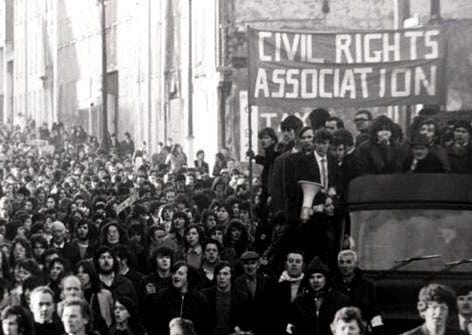Sunday, the 9th of April 1967 was a day for new beginnings; The Boeing 737 made its maiden flight, flying from King County International Airport (near Seattle) to Paine Field (Everett), and the Northern Ireland Civil Rights Association got together to formalise its constitution.
Ever since the formation of Northern Ireland in 1922, as a minority, Catholics were subjected to varying levels of discrimination. This was the case across many areas; employment, politics, policing, housing, and even education. Since the early 60s, there had been a long-standing desire to try and publicise the level of discrimination, through the Campaign for Social Justice and the Homeless Citizens League. Both groups held rallies and marches to press for fair allocation of housing and helped bring the anti-Catholic discrimination to the attention of the media and those at Westminster. It’s also worth remembering that during this time, there was also a civil rights movement gathering momentum across the pond in America, led by Martin Luther King Jr, highlighting that this wasn’t an isolated issue within Northern Ireland.
It was widely believed that the idea of a non-partisan civil rights campaign was a way for republicanism to permeate a protestant majority workforce to help with its agenda of undermining Ulster Unionism. This belief was fuelled by events of the past where the IRA were believed to have tried to infiltrate Northern Ireland’s trade unions in the 1930s.
The civil rights movement had been active for many years, and it was in August 1966 that a meeting was held at the home of republican solicitor Kevin Agnew in Derry. At the meeting were the Wolf Tone Societies (an Irish Republican Group), and the IRA’s chief of staff Cathal Goulding. It was during this meeting that it was agreed that they would drop the Wolf Tone tag and instead focus their energy on creating broader civil rights objectives. This led to a seminar that was held in Belfast in November 1966. The meeting had many speakers, mainly from the Irish Anti-Apartheid Movement, Kader Asmal (South African born Law lecturer), and Ciarán Mac an Áilí (member of the International Commission of Jurists).
The civil rights movement called for several reforms, one of which was for ‘one man. one vote’. At the time it was only ratepayers were entitled to vote!
Did you know that I’m an independent writer? If you’re enjoying the content, why not buy me a coffee to help me keep doing what I do (caffeine keeps me writing!)?
Following the seminar in Belfast, it had been agreed that there should be another meeting to launch a civil rights body. This meeting took place on the 29th of January 1967 with Tony Smythe and James Shepherd of the National Council of Civil Liberties, alongside over 100 others from varying organisations, in attendance (which included Northern Ireland political parties).
This meeting was the birthplace of a 13-member steering committee that would go on to draft the NICRA’s constitution. The 13 members were as follows;
Chairman: Noel Harris (a trade unionist and member of the Draughtsmen and Allied Trades Association and the Communist Party).
Vice-Chairman: Conn McCluskey (one of the founders of the Campaign for Social Justice).
Secretary: Derek O'Brien Peters (of the Communist Party).
Treasurer: Fred Heatley (of the Wolfe Tone Societies).
Information Officer: Jack Bennett (a journalist with The Belfast Telegraph).
Betty Sinclair (a communist member of the Belfast Trades Council).
Liam McMillen (vice-chairman of the Republican Clubs and Commanding Officer of the IRA Belfast Brigade).
John Quinn (of the Ulster Liberal Party).
Professor Michael Dolley (of Queen's University Belfast, a civil libertarian and member of the National Democratic Party in Northern Ireland).
Joe Sherry (of the Republican Labour Party).
Jim Andrews (of the Ardoyne Tenants Association).
Paddy Devlin (of the Northern Ireland Labour Party).
Tony McGettigan.
It’s clear that no original member of the committee self-identified as a unionist, or can be even described that way. This led to Robin Cole (former chairman of the Young Unionists at Queens University) being co-opted onto the committee by unanimous decision. This meant that the form NICRA was taking was one determined by a coalition of forces that came together to create it, making it clear that republicans were only one element and strengthening their stance that civil rights were a banner that many could get behind, whether republican, communist, nationalist, socialist, liberal, unionist, or even if you were unaffiliated.
When formalising the constitution, NICRA emphasised their character as non-party and non-denominational, and as a body which would make representations on the broad issues of civil liberties. They also claimed that they would take up individual cases of discrimination and ill-treatment, stating their aims as "to assist in the maintenance of civil liberties, including freedom of speech, propaganda and assembly".
Their 5 aims were;
To defend the basic freedoms of all citizens.
To protect the rights of the individual.
To highlight all possible abuses of power.
To demand guarantees for freedom of speech, assembly and association.
To inform the public of their lawful rights.




